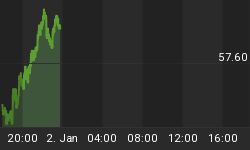The good news is:
• The current decline should end soon leaving the market at a goodpoint from which to advance.
Short term
The NASDAQ new low indicator (OTC NL) is a 10% trend (19 day EMA) of NASDAQ new lows. OTC NL is plotted on an inverted Y axis so that then new lows are increasing the indicator moves downward and when new lows are decreasing the indicator moves upward (up is good). OTC NL is the best indicator I know of for identifying market bottoms. OTC NL often gives false positives so it is prudent to wait until the indicator has been moving upward for 5 consecutive days before assuming a change in trend.
In the chart below the NASDAQ composite (OTC) is shown in red and OTC NL in blue. NL is still heading downward.

The chart below shows the OTC in red and a MetaStock indicator called standard deviation channel in blue. The upper and lower lines are drawn 1.5 standard deviations either side of a linear regression trend line. Since early August there has been a pattern of lower highs and lower lows. Last week the OTC fell from near the upper band to near the lower band.

Bollinger Bands (BB's) are drawn 2 standard deviations either side of a simple 20 day moving average. The chart below shows the OTC in red, BB's and the 20 day moving average in green. BB's often mark the upper and lower limits of a short term move. The OTC is at the lower BB so it is likely the OTC will move upward or at least sideways for the next several days.

Intermediate term
Summation indices (SI) are running totals of oscillator values.
The chart below shows the OTC in red, OTC AD SI calculated from NASDAQ advancing issues - declining issues, OTC HL SI calculated from NASDAQ new highs - new lows and OTC UD SI calculated from NASDAQ upside - downside volume. Last week all of the NASADAQ SI's turned downward.

Seasonality
On average, January is the strongest month of the 1st year of the presidential cycle followed by October. The 1st year of the presidential cycle has been up 60% of the time with an average gain of 6.8%. In 1973 (a presidential cycle 1st year) each of the 1st 6 months of that year were down as well as October and the OTC finished the year down 31.1%. This year the 1st 4 months of the year were down as well as the 1st week of October (usually one of the strongest weeks of the year). In 1974 the OTC was down 35.1% second only to 2000 when it was down 39.3%. I think the weakness of the past week bodes poorly for the remainder of this year and next.
Conclusion
Every indicator that matters is heading downward so this decline is likely to have further to go. However, for the very short term, the market is oversold and near the bottom of its recent trading channel so a short term bounce is likely.
I expect the major indices to be higher on Friday October 14 than they were on Friday October 7.
Last weeks positive forecast was a miss, I overestimated the effect of seasonal strength at the beginning of the month.
This report is free to anyone who wants it, so please tell your friends. They can sign up at: http://alphaim.net/signup.html If it is not for you, reply with REMOVE in the subject line.
Gordon Harms does a Power Point for our local market timing group. It is nearly 2mb and you can download it from: http://www.stockmarket-ta.com/Research/Oct-4-2005.PPT















